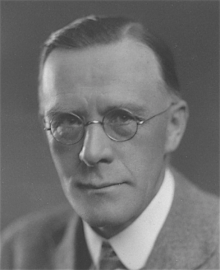
William Henry Ansell [also known as W.H. Ansell] was born in Nottingham, Nottinghamshire, England, on 23 November 1873. He was articled to John Reginald Naylor (1854-1923 and George Hanson Sale (1857-1945) of Naylor & Sale in Derby, Derbyshire in 1892 and then remained with them for a further two years as their assistant. In 1897 he moved to London where, in 1898-99 he worked in offices of John Belcher 1841-1913), Halsey Ralph Ricardo (1854-1928) and Richard Creed (1846?-1914). He also studied architecture at the Architectural Association Schools in London and etching at the Royal College of Art in London under Sir Frank Short [dates not known].
In 1899 Ansell qualified as an architect and the following year set up his own independent practice in London. Between 1934 and 1949 he was in partnership with Arthur Bailey (1903-1979) as Ansell & Bailey. A photograph of the entrance hall at 'The Brae', Farnham designed by Ansell is illustrated in 'The Studio Yearbook of Decorative Art' 1907 (p.49).
Ansell was elected an Associate of the Royal Institute of British Architects (ARIBA) in 1900, and a Fellow of the Royal Institute of British Architects (FRIBA) in 1922. He served as President of the Architectural Association in 1928 and President of the Royal Institute of British Architects (PRIBA) from 1940 to 1943 . He became a member of the Art Workers Guild (AWG) in 1913 and served as Master of the AWG in 1944.
Ansell exhibited at the Royal Academy and the Royal Society of Painter-Etchers and Engravers in London; Nottingham Museum and Art Gallery; and the Walker Art Gallery in Liverpool. An oak armchair designed by Ansell was shown in the 6th exhibition of the Arts & Crafts Exhibition Society in London in 1899; and a hall coffer and a fire-guard designed by Ansell and C. J. Harold Cooper were shown in the 7th exhibition of the Arts & Crafts Exhibition Society in London in 1903.
He was elected an Associate of the Royal Academy (ARA) and an Associate of the Royal Society of Painter-Etchers (ARE) in 1909. Ansell had an office at 12 Gray's Inn Square, Gray's Inn, London. He lived for many years in Sevenoaks, Kent, where he died on 11 February 1959
Architecturalprojects by Ansell included houses in Derby (1899); the Isolation Hospital in Sevenoaks, Kent (1900), business premises at Lancaster Court, London (1901); The Brae in Farnham, Surrey (1904); Knappe Cross in Exmouth, Devon (1906-08); houses in Radlett (1909-10); the Church of Humanity in Liverpool (1912-13); a house in Worplesdon (1913-14); Temple of Humanity for the Positivists at Upper Parliament Street, Liverpool (1914); convalescent homes at St. Margaret's Bay, Kent (1919) and Everleigh, Wiltshire (1920); head offices of the National Deposit Friendly Society in Queen Square, London (1920-23); the Butchers Charitable Institution in Hounslow (1922-23); and the Convalescent Memorial Home in Skegness (1924-25).
‘Convalescent home in Surrey (the Zachary Merton); Architect: W. H. Ansell.’ Architects’ Journal 9 January 1941 p. 7
Directory of British Architects 1834-1914. Compiled by Antonia Brodie, et al. Volume 2: L-Z. London; New York: British Architectural Library, Royal Institute of British Architects/Continuum, 2001
Gray, A. Stuart. Edwardian Architecture: a Biographical Dictionary. London: Gerald Duckworth & Co., Ltd., 1985
'Obituary'. AA Journal vol. 74, 1959 p. 240
'Obituary'. Architect’s Journal vol. 129, 26 February 1959 p. 326
'Obituary'. RIBA Journal vol. 66, March 1959 p. 257
'Obituary'. The Builder vol. 196, 20 February 1959 p. 373
'Obituary'. The Builder vol. 196, 27 February 1959 p. 411
'Senior elementary school at Scalby, Yorks; Architects: F. X. Velarde, W. H. Ansell'. Architects' Journal 1 October 1942 pp. 217-222, xxvi.